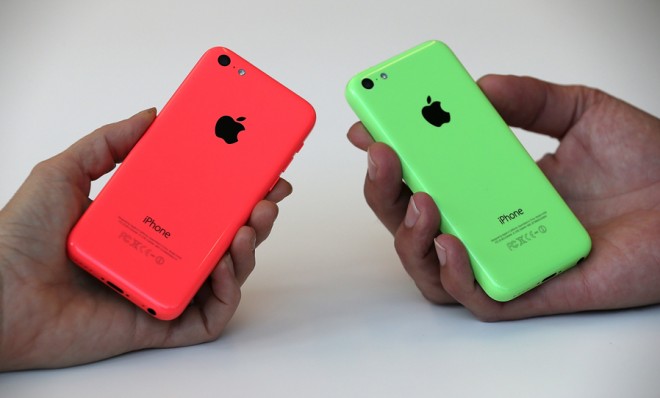The 'C' in iPhone 5C doesn't stand for cheap
Analysts expected the unsubsidized phone to cost around $400. It's way more expensive than that.

The high-end, biosensor-equipped iPhone 5s may be the most "forward-thinking phone anyone has ever made," as Apple head of marketing Phil Schiller described it yesterday. But it's the plastic iPhone 5C that may actually end up being more critical to Apple's future.
The "C" has already been widely appropriated as a stand-in for a number of things: "Color," "choice," "core," and even "China," where the company is struggling to carve out market share. What the "C" doesn't stand for, however, is "cheap."
Some analysts expected the unsubsidized iPhone 5C to debut in the $400 range, which would make it significantly more affordable in markets outside of the United States where carriers don't subsidize the retail cost. Although some carriers like T-Mobile offer consumers unsubsidized phones (which have higher upfront cost but carry lower monthly burdens), for the most part, the iPhone 5C will run you $99 for the 16GB version on a two-year contract.
The Week
Escape your echo chamber. Get the facts behind the news, plus analysis from multiple perspectives.

Sign up for The Week's Free Newsletters
From our morning news briefing to a weekly Good News Newsletter, get the best of The Week delivered directly to your inbox.
From our morning news briefing to a weekly Good News Newsletter, get the best of The Week delivered directly to your inbox.
The New York Times reports that a sub-$400, or even sub-$500 iPhone isn't in the cards. In China, the iPhone 5C will start at 4,488 renminbi, or roughly $733, which is a 33 percent markup from the unsubsidized $549 cost here in the United States. "If you look at the price, it's clearly a high-end phone, not a low- or even midrange phone," Jenny Lai, an analyst at HSBC in Taipei, tells the Times.
So what gives? Typically, the previous year's iPhone model — in this case, that would have been the iPhone 5 — slides down to occupy the mid-priced slot ($99 on a two-year contract) in Apple's three-phone lineup, while the previous model before that sells for $0 on a two-year contract (in this case, the iPhone 4S).
This year is different, though. Aside from a few tiny spec improvements and the polycarbonate backing (which comes in six colors), the iPhone 5C is essentially the same phone as the iPhone 5, which it is replacing in the middle slot.
John Gruber at Daring Fireball thinks it's purely a marketing gamble to help differentiate the iPhone 5 from the new iPhone 5s. "Yes, it's plastic, but there's nothing cheap about it," writes Gruber. "This move is about establishing the iPhone as a two-sibling family, like how the MacBooks have both the Airs and the Pros. Think of the 5C as the Air, and the 5s as the Pro. Or iMac and Mac Pro. The iPhone is growing up as a product family."
A free daily email with the biggest news stories of the day – and the best features from TheWeek.com
"It eliminates the confusion that would have been caused by the iPhone 5s and the iPhone 5 looking nearly identical to one another (subtle gold, notwithstanding). It seems like a win-win-win for Apple," says MG Siegler at TechCrunch. "But it's not going to be viewed as a 'win' by tech pundits and Wall Street."
Splitting the iPhone lineup into two clearly demarcated iPhones isn't entirely unprecedented. "Historically, Apple has done quite well for itself using mid-tier products with lots of aspirational appeal to draw budget-conscious consumers into a higher price range," says John Paczkowski at All Things D. "It did it with the iPod nano, and again with the iPad mini."
In China, where Apple products have always been more expensive compared to the United States due to the country's value-added taxes, which hover at 17 percent, some analysts think the iPhone 5C's steep price markup could potentially give Apple more pricing maneuverability in the future. "It looks like they are trying to test the market," Bryan Wang, an analyst at Forrester Research, tells the Times. Essentially, Apple is asking: "How much are Chinese consumers willing to pay for the phone?"
-
 Donald Trump’s squeeze on Venezuela
Donald Trump’s squeeze on VenezuelaIn Depth The US president is relying on a ‘drip-drip pressure campaign’ to oust Maduro, tightening measures on oil, drugs and migration
-
 US citizens are carrying passports amid ICE fears
US citizens are carrying passports amid ICE fearsThe Explainer ‘You do what you have to do to avoid problems,’ one person told The Guardian
-
 All roads to Ukraine-Russia peace run through Donetsk
All roads to Ukraine-Russia peace run through DonetskIN THE SPOTLIGHT Volodymyr Zelenskyy is floating a major concession on one of the thorniest issues in the complex negotiations between Ukraine and Russia